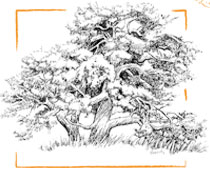Researchers collect pre-burn data for the upcoming TREX prescribed burn this fall
September 2023
Kristen Zumdahl
 |
| Sedgwick Reserve will be hosting its second Prescribed Burn Training Exchange (TREX) in November 2023. The TREX provides training opportunities in alignment with fire management and community goals. In addition to field training, TREX participants engage in lectures, discussions, field trips, and networking opportunities on topics related to fire ecology, tribal burning, and prescribed fire planning. The TREX offers opportunities to bring together fire management professionals, local tribes, and researchers all for the common goal of understanding the role fire plays in our ecosystem and community safety. As part of the planned prescribed burn, PhD candidate Kaili Brande from the University of California, Santa Barbara is working on understanding how oak trees are affected by fire. Her work includes collecting data before, during, and after the burn as well as collecting data in control plots outside the burn for comparison. In photo 1 (above), Kaili and her team are conducting bark heating experiments across three species of oaks: blue oak (Quercus douglasii), coast live oak (Quercus agrifolia), and valley oak (Quercus lobata). The purpose of this experiment is to test the bark’s heat resistance across many size classes of trees. Findings from this project will help determine the minimum bark thickness and tree size required for a tree to be resilient to fire-induced death from surface and/or ground fires. |
 |  |
| In photos 2 and 3, a small 1.5 inch hole is drilled into the tree and the outer bark is removed, exposing the cambium layer. This small hole created by the drill is not fatal to the tree and the tree is able to recover afterwards. The cambium is the living tissue layer underneath the bark that contains important water and nutrient transportation pathways for tree growth. Excessive death of the cambium, which can occur under intense fire conditions, is fatal to the tree. The experiment also uses a heat gun, which applies heat directly to the bark for up to 15 minutes. Temperature sensors are placed under the bark (against the cambium-layer) and on top of the bark to measure time-to-cambium-kill, the amount of time it takes for constant heat exposure to simulate the kill of the cambium layer. In part, Kaili’s research seeks to understand how much time it takes heat to kill the cambium and how the time-to-cambium-kill interacts with other factors (wind, ambient temperature, relative humidity, etc.) Kaili’s research allows us to study how fire affects oaks in a safe and controlled setting. This knowledge can be used to inform land management to better prepare for wildfires (and better plan prescribed fires) in oak forests. The 50-acre TREX burn will occur in the southwest corner of the Reserve in November 2023 and includes a mosaic coastal sage scrub (dominants include purple sage (Salvia leucophylla), California sagebrush (Artemisia californica), deerweed (Acmispon glaber), foothill needlegrass (Stipa lepida), mixed oak woodland (blue oak (Q. douglasii), coast live oak (Q. agrifolia), and a few valley oaks (Q. lobata)), and annual grassland dominated by wild oat (Avena fatua). |
